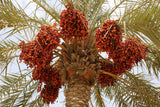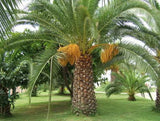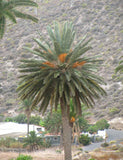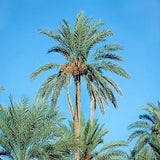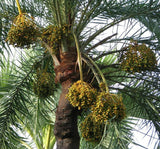🌴 Product Description: Phoenix dactylifera (Date Palm) Seeds
Plant the seeds of ancient legend and modern wonder — Date Palm seeds unlock the story of civilization. These majestic trees have stood as pillars of life across deserts and oases for millennia.
🌼 Bloom Color & Fragrance
-
Bloom Color: Subtle white to pale yellow flower clusters borne on long branched spadices emerging in late winter to spring.
-
Fragrance: Flowers are lightly fragrant, adding a whisper of sweetness to warm desert air.
❄️ Hardiness & Growing Zones
-
USDA Hardiness Zones: Zones 8–11. Date palms are moderately frost-tolerant—surviving down to around 20 °F (–6 °C) in arid climates.
-
Hardiness Notes: With deep roots, these palms thrive as if their "feet are in water and their head in fire"—flourishing under intense desert heat and abundant under‑ground moisture.
🐞 Wildlife & Ecological Uses
-
While Phoenix dactylifera is not a known butterfly larval host, it supports several Lepidoptera larvae, including species like Batrachedra amydraula and Paysandisia archon, and serves pests like the palm‑borer Diocalandra frumenti.
-
Pollination: Primarily wind-pollinated, though small insects may assist. In cultivated plantations, manual pollination from selected male trees is widely practiced to ensure consistent fruit quality and yield.
🌍 Cultural Significance & Fascinating Facts
-
Anchor of Civilizations: Cultivated for over 5,000 years across Mesopotamia and the Middle East, date palms played a critical role in sustaining early desert cities and caravan cultures.
-
Spiritual Symbolism: Revered across Abrahamic religions—dates are mentioned numerous times in the Bible and Quran; date palms symbolize fertility, victory, and peace. Fronds are used in rituals such as Palm Sunday and Sukkot.
-
Global Staple Crop: Today, over 100 million date palms are cultivated worldwide, supporting economies in North Africa, the Middle East, Southwest Asia, and even desert regions of California and Mexico.
-
Seed Genetic Magic: Only about half of seed-grown palms are female (fruit-bearing)—and seed-grown palms take 4–8 years to flower, with fruiting usually appearing in year 7–10.
🌱 Growing Guide
-
Soak seeds for 2–3 days in warm water, then sow in light, well-drained medium at around 25–30 °C for best germination.
-
Plant outdoors after danger of frost; in cooler climates, start indoors and transplant when conditions allow.
-
Provide full sun and sandy, alkaline-loamy soil, with access to deep water—perfect for desert-like conditions.
-
Long-term growth: Mature palms can reach 50–80 ft tall with massive crowns and lifespans exceeding 100 years.
-
Consider both sexes: you’ll need at least one male for every 6–10 females to set fruit; many seed-grown plants must be sexed later to identify fruit‑bearing females.
🌟 Why You’ll Treasure These Seeds
-
Grow a living legacy: From ancient oases to modern gardens, these trees carry half a millennium of human history.
-
Edible rewards (with patience): Although seed-grown palms take years to fruit, the promise of sweet, chewy dates is real.
-
Cultural resonance: Each palm connects to traditions—from Quranic symbolism to Palm Sunday and ancient coins.
-
Desert-hardy beauty: Majestic, drought-loving, and built to endure sun-baked climates—and a frost or two.
-
Ecological intrigue: While not major insect magnets, these palms weave into desert ecosystems and support specialized wildlife.
Planting these seeds means committing to decades of growth, history, and slow-blooming wonder. And with time, you may transform a barren corner into a swaying legacy of shade, story, and sweet dates.






